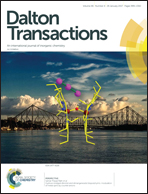Influence of bidentate ligand donor types on the formation and stability in 2 + 1 fac-[MI(CO)3]+ (M = Re, 99mTc) complexes†
Abstract
In the last two decades, a number of chelate strategies have been proposed for the fac-[MI(CO)3]+ (M = Re, 99mTc) core in radiopharmaceutical applications. However, the development of new ligands/complexes with improved function and in vivo performance has been limited in recent years. Expanding on our previous studies using the 2 + 1 labeling strategy, a series of bidentate ligands (neutral vs. anionic) containing an aromatic amine in combination with monodentate pyridine analogs or imidazole were explored to determine the influence of the bidentate and monodentate ligands on the formation and stability of the respective complexes. The 2 + 1 complexes with Re and 99mTc were synthesized in two steps and characterized by standard radio/chemical methods. X-ray characterization and density functional theory analysis of the Re 2 + 1 complexes with the complete bidentate series with 4-dimethylaminopyridine were conducted, indicating enhanced ligand binding energies of the neutral over anionic ligands. In the 99mTc studies, anionic bidentate ligands had significantly higher formation yields of the 2 + 1 product, but neutral ligands appear to have increased stability in an amino acid challenge assay. Both bidentate series exhibited improved stability by increasing the basicity of the pyridine ligands.
![Graphical abstract: Influence of bidentate ligand donor types on the formation and stability in 2 + 1 fac-[MI(CO)3]+ (M = Re, 99mTc) complexes](/en/Image/Get?imageInfo.ImageType=GA&imageInfo.ImageIdentifier.ManuscriptID=C6DT04282A&imageInfo.ImageIdentifier.Year=2017)


 Please wait while we load your content...
Please wait while we load your content...